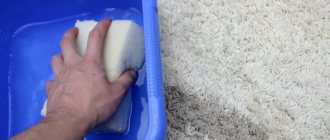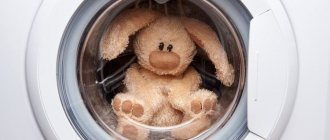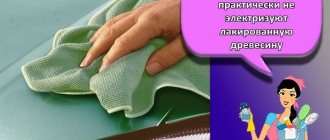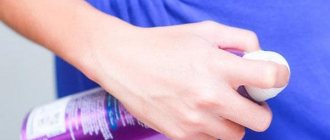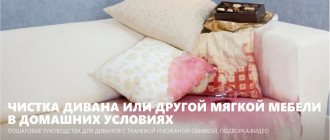Baking soda is a universal folk remedy for cleaning. They wash and clean almost all surfaces. Soda is safe for health, does not cause allergies, leaves no odor, is cheap and perfectly cleans a wide variety of stains. Therefore, it is convenient to use, for example, for cleaning furniture and carpets in a house where there are small children or people sensitive to household chemicals. We offer 10 proven recipes and expert advice on how to efficiently and safely clean a sofa with baking soda at home.
Precautions and basic cleaning rules
Baking soda is gentle and can be considered a gentle cleaning agent. But this does not mean that it is always safe for all types of sofa upholstery. Experts warn: any folk recipe, even one that has been proven for decades, must be tested on an inconspicuous area of the sofa. There is an increased risk for leather upholstery, as well as for fabrics containing silk, linen, cotton, and wool fibers. After unsuccessful cleaning, they may change structure or color.
Therefore, before cleaning the entire sofa upholstery with soda, carry out a test procedure somewhere in a corner or on the back wall of the furniture. Make sure that after cleaning and drying the material has not become harder, the pile has not started to “climb”, and the colors have not changed. Only in this case can the selected recipe be used to process visible parts of the seat and backrest.
In addition, try to follow these rules for cleaning your sofa with baking soda:
- Before starting treatment, be sure to vacuum the sofa thoroughly (remove dust from leather upholstery with a soft, dry cloth). This will improve the quality of cleaning and prevent the appearance of unsightly dirty stains.
- If you choose to wet clean, be careful not to wet the sofa excessively. Moisture that gets into the filler will cause mold to appear - the fungus settles in wet furniture within the first day. The words “rinse the upholstery” in any recipe mean that the fabric should be gently wiped with a damp sponge, rather than soaked in water. The sponge should be rinsed frequently in clean water and wrung out well. This work requires a lot of time and effort, but this is the only way your sofa will become clean and will not suffer during the cleaning process.
- Remove baking soda from upholstery as best you can - wash or vacuum it. If the product is left on the couch, it is unlikely to harm him or you. But over time, soda will begin to absorb moisture from the air, become sticky and “attract” dust. The sofa will get dirty very quickly.
- Always dry furniture thoroughly after wet cleaning. It can be wiped dry with a cotton cloth, blotted with paper towels, and dried with a fan or hair dryer. But never dry the upholstery with an iron and hot air. Also, do not leave the sofa to dry in the sun - the colors of the upholstery fabric can fade very quickly.
- For upholstery that does not like moisture (silk, tapestry) or gets wet very quickly (linen, cotton), it is better to choose cleaning with minimal use of water.
- Many upholsteries also do not like excessive friction (flock, chenille, velvet, velor, silk fabrics). They need to be cleaned very carefully, with a soft brush or flannel, and vacuumed with a nozzle without bristles.
Below are ten options on how you can use baking soda to clean a sofa from general dirt and individual stains. Choose the method that suits your furniture.
Folk recipes for cleaning a sofa with baking soda at home
For removing light stains and unpleasant odors (urine, beer), for cleaning a light-colored sofa or delicate upholstery that does not like moisture
2. Wet processing.
To remove grease, refresh color, to treat the entire sofa or its individual parts, to remove stains from tea, coffee, dirt, paint, ballpoint pens
3. Cleaning with soda slurry
This method also helps remove grease, tea, coffee and dirt stains. It is more effective, but also more complex to implement than the previous one.
4. Cleaning with soda solution
This method is suitable for quickly cleaning a sofa from light stains with baking soda. Suitable only for upholstery that is not afraid of moisture.
5. General cleaning with baking soda and detergent.
To remove heavy dirt, stubborn stains, and traces of urine.
6. Powerful cleaning of the sofa with soda, vinegar and Fairy.
An even more effective product for general cleaning and removing the toughest stains
7. Refreshing cleaning with baking soda and vinegar.
To remove light stains, remove odors, restore color and soften upholstery lint
8. Cleaning the sofa with alcohol and soda.
For removing fresh grease stains
9. Cleaning the sofa with soda and peroxide.
For removing stains from fruits, berries, juices, “colored” vegetables, wine, tea and coffee
10. Cleaning a leather sofa.
For removing shiny stains from leather, eco-leather and leatherette
| Type of cleaning | Cleaning process |
| |
| |
| |
| |
| |
| |
| |
| |
| |
|
How can you treat your bed for lice?
Treatment
bed after
lice
is carried out by knocking out and drying in the sun. To increase the efficiency of feather products, go through a steam iron; Pack soft and fabric toys in a plastic bag and leave for 10 days. Without oxygen, parasites die and nits cannot develop.
Interesting materials:
Where to advertise for the sale of real estate? Where to put rotten pears? Where to put old movie discs? Where to put the mowed grass on the site? Where to put old household appliances? Where should the windows go? Where to invest 100k? Where to use pine litter? Where to use moss? Where to use dried cement?
Cleaning a fabric sofa from dirt, dust and grime
Depending on the degree of contamination of the fabric covering, we use the required cleaning method:
- slight dirt, dust
Dissolve 4 tbsp in 3 liters of water. l. dishwashing detergents. Add 150 ml of vinegar and beat into foam. Apply it to the upholstery and leave for 30 minutes. Gently wipe the stains with a brush and leave for another 30 minutes to dry. Clean thoroughly with a vacuum cleaner.
- heavy pollution
In a spray bottle, mix 100 ml of vinegar, 1 tsp. dishwashing detergent and 400 ml hot water. Add 1 tsp. soda and quickly close. Spray on the surface of the sofa and wait 5 minutes. Wipe off heavy dirt with a brush. After removing stains, wipe the surface with a clean damp sponge. Next, wipe dry with a towel and dry the surface.
Prepare a mixture of vinegar, ammonia and warm water in a ratio of 1:1:20. Apply to the surface of the sofa with a sponge. Wipe off any dirt with a rag and rinse off the mixture with water.
Getting rid of odors and refreshing the color of the upholstery
This is a gentle method of cleaning upholstery from dust and odor, which will additionally restore its color. We use it to clean all types of fabric. Mix 1 liter of water, 1 tsp. vinegar and 2 tsp. salt. Wet the sponge with the mixture and squeeze it well. Wipe the surface with light movements in the direction of the pile. Rinse the sponge as soon as it becomes dirty.
Cleaning a sofa with different coverings. Types of materials and features of its processing
Fabric upholstery of furniture can be made of different coatings, with their own characteristics and contraindications for care:
Cleaning such a surface does not cause many problems. The main rule when cleaning dermantine coating is not to over-wet it. Remove stains with egg white, after beating it until it forms a thick foam. Apply it to the dirt and leave it for 5-7 minutes, and then wipe it off.
We soak a microfiber cloth with a vinegar solution (1 teaspoon of vinegar per 1 liter of water) and clean the dirt with light movements in the direction of the pile. To remove complex stains, we turn to dry cleaning.
- suede and nubuck
To clean such a coating, use a brush with soft bristles. Remove grease stains with an eraser or alcohol solution. We recommend regular treatment with impregnations that repel dirt.
A very capricious and demanding coating that can only withstand dry cleaning with a vacuum cleaner. Cleaning products negatively affect the quality of upholstery and its color. Wet processing is possible only with foam; we try to minimize the volume of moisture.
We clean with three drops of any detergent that foams, diluted in 1 tbsp. water. We remove dirt with this solution.
- velvet and silk
We clean this coating with special cleaning agents.
General recommendations
Upholstered furniture is upholstered with textiles, artificial, less often natural, as well as eco-leather. Fabric upholstery varies in composition and weaving method; accordingly, they differ in strength, resistance to moisture and chemicals. In order not to spoil the upholstery, it is enough to follow a few key rules:
- Avoid heavy contamination, and to do this, clean the furniture periodically, 1-2 times a week, and remove complex stains, for example, from a pen or berries, immediately, not allowing them to penetrate deep into the fibers.
- Carry out dry cleaning (leather furniture can be wiped with a damp, but not wet cloth), and wash or wash it once a month.
- If you need to wipe off an accidental stain or a handle, try to wet the upholstery less, especially furniture fabric, and after washing it, wipe it or blot it thoroughly so that all the moisture is gone. Otherwise, the filler will become damp and fade, or become a haven for mold.
- Before general cleaning, be sure to remove the top layer of dust and lint using a vacuum cleaner or soft brush.
- Before use, test aggressive detergents on a sample of upholstery or an inconspicuous area of furniture.
Removing stains from a sofa using folk remedies
The origin of the stain also plays a big role when choosing a cleaning method:
Cover the stain with baking soda or salt and leave it to absorb the grease. Then remove it with a soft sponge. If a trace remains, use dishwashing detergent after foaming it.
Remove with water and dry the coating thoroughly. If the stain is old, cover it with ice and let it sit longer. Soak with vinegar solution (2 tbsp per 1 liter of water), and then wash with soap and water.
Prepare a solution with ammonia and vinegar, mixing them 1:1. Apply the mixture to the stain and wait for it to dry. Clean with a damp cloth.
Blot with a napkin and cover with salt. After it has absorbed moisture, shake off the salt and wash with ethyl alcohol and then with soapy water. Clean with clean water and dry.
Dry with a hairdryer or towel. Then treat with vinegar solution (3 tbsp per 1 liter of water).
We wipe off the dirt with soap, without water. Then wipe with a damp cloth. If the contamination is old, use soap foam.
Wrap the ice in a bag and apply it to the gum. After freezing, clean it with a plastic object. We treat the trace with an alcohol solution.
We wait until it hardens, scrape off the wax, cover the mark with 2-3 napkins and iron it.
Immediately after the stain appears, blot it with napkins and dry it. Treat with a vinegar solution (1:5) if the coating is colored, or with a citric acid solution (1:10) if it is light. Leave for 1 hour and wash with soapy water, then with clean water and dry.
- pen, felt-tip pen, lipstick, nail polish
Soak it in ammonia or acetone and then rinse.
Preventive measures
It is quite difficult to get rid of any dirt on upholstered furniture. In addition, it is not always possible to achieve the desired result.
To avoid stains, it is recommended to follow several preventive measures:
- If there are small children or pets in the house, then cover the upholstered furniture with a blanket or cover (modern factories offer a wide selection of beautiful models). This should be done before every feast. Firstly, the cape is easy to remove and machine wash. Secondly, if the stain does not wash off, then it is easier to replace it with a new one than the upholstery.
- If dirt does appear, wash it off immediately, since ingrained stains are much more difficult to deal with.
Upholstered furniture creates coziness and comfort in the room. It’s so nice to relax on it after a hard day or enjoy a family dinner. To prevent the upholstery from losing its aesthetic appearance, it is enough to vacuum it from time to time, and if random stains appear, special household or folk remedies will help.
Ready-made chemicals
You can also clean the sofa with chemicals. While studying the sofa cleaning product, we familiarize ourselves with its description and rules of use. The description indicates what type of fabric it is intended for:
- "Vanish " The line of this product includes shampoo, antibacterial agent and powder. For coatings that do not tolerate moisture, we use the latter (cleaning using the dry method);
- "Marseille Soap" . Contains olive oil and baking soda. Used to clean small stains. Wet the soap, rub the stained area and after 20 minutes rinse with a damp cloth;
- "Denkmit" - foam for cleaning carpet and sofa upholstery. We use it for velvet, tapestry and silk coverings;
- "Sama " Effectively fights old stains, dirt and bacteria;
- Bagi "Shtihonit" . We use it as a stain remover and as a complete cleaning agent;
We also recommend that all housewives find out how to wash kitchen towels from old grease stains and odors.
- "Pro Brite " An environmentally friendly product, suitable for people with allergies. It has a sprayer that is convenient for applying the product to local areas of the upholstery;
- "Dufta" , "Simple Solution" , "Nature's Miracle" . These products effectively combat unpleasant odors and completely eliminate them.
Useless sofa cleaning products
There are tools that do not cope with their task:
- "Carpet" . Doesn't remove stains and smells bad.
- "Nordland" . After use, stains remain on the upholstery, does not remove stains and consists of harmful chemical compounds.
- "My family" . The product is not able to remove even minor stains.
- "Cinderella" . We use it for daily cleaning as it removes only fresh stains.
Among all the tasks facing disinfection, the problem of disinfecting furniture, including medical furniture, is highlighted. A well-known saying says that “the devil is in the details” - this is especially true for disinfecting tables, chairs, lamps, and other interior items. The whole complexity of the process lies in choosing the appropriate disinfectant and the method of its use - after all, modern cabinets and sofas are made from thousands of materials with different characteristics. Factors such as porosity, water resistance, and padding material directly affect the final effectiveness of the interior disinfection process.
Parasites in mattresses: uninvited guests guarding your sleep
A comfortable and properly selected mattress is the key to healthy sleep. However, if not properly cared for, a mattress can contribute to the occurrence of certain diseases of its owners, as well as cause considerable discomfort. Where do these unpleasant phenomena come from? The thing is that it is the mattress that can become a haven for parasites if it is not provided with proper care.
Types of parasites found in mattresses
Sadly, the comfortable and soft mattress on which you slept so comfortably yesterday can become home tomorrow to the following types of parasites - dust mites and house bugs. These types of insects are very often found in mattresses. Of course, they can be found in other secluded places in the apartment, but it is on the bed that insects find the source of their food - humans, during their highest activity - from 1 am to 6 am.
What are the differences between mattress parasites?
- Dust mites are insects that do not directly disturb the sleeper, as they are saprophytes. They only collect dead human skin cells - that is, a product that the body no longer needs. However, the problem is that dust mites leave behind feces that can cause allergies and lung diseases in humans.
- House ticks are a more serious health threat. These insects inflict small bites on humans - they not only cause discomfort, but also cause severe itching, allergies, and infection.
Thus, you can understand what harm parasites in a mattress can cause to a person. That is why it is necessary not only to fight insects, but also to take preventive measures.
Prevention
Surely many will be interested in the question, where do parasites come from, especially if the mattress is new? Note that insects can migrate from neighbors, and they can be brought in by guests with some things. In addition, if you purchased a new mattress and the old one is still in the apartment, the parasites may move to a new home.
What can I do to minimize the possibility of parasites?
- It is necessary to regularly change bed linen, wash it (preferably at a fairly high temperature), and iron it.
- You should also systematically carry out high-quality cleaning of the apartment, eliminating dust.
- To protect the mattress, it is necessary to use mattress pads and covers that have a moisture-proof surface.
- Clothes should be kept further away from the bed.
How to recognize parasites?
A mattress is simply an ideal habitat for insects - after all, it is a dark place where it is warm and there is a certain level of humidity. It is worth noting that the quality of the mattress plays an important role, and it is imperative to choose a durable and strong mattress. After all, parasites are able to get through weak seams of a product, so reliable stitching is extremely important.
If there are parasites in your mattress, you will certainly notice some signs:
- Characteristic brown streaks appear on the material of the mattress or bed linen.
- When a person crushes insect larvae, a specific smell appears, which is quite noticeable.
- Small bites remain on the body, but they are accompanied by itching, which will immediately make itself felt.
- If a person unintentionally scratches the affected skin while sleeping in the morning, a person may notice red dots or spots.
In war, all means are good
Dust mites are parasites that will, in any case, live in your apartment to some extent, but their number can and should be reduced. All measures to destroy dust mites should also be linked to the fact that they multiply quite quickly. The same statement applies to domestic bugs, which cause even more harm.
Thus, it is worth highlighting several effective methods of combating parasites living in mattresses:
Thermal methods
This category includes cold or heat treatment. It must be remembered that a certain temperature level is unfavorable for the life of parasites. In winter it is -20 degrees Celsius - this is the temperature at which insects die. Just expose the mattress to the cold if its size allows and the temperature outside is appropriate. As for heat treatment, parasites die at a temperature of +50 degrees Celsius. Thus, you can not only expose the mattress to the hot sun in summer, but also use a stream of hot air and boiling water.
Chemical methods
There are both special means for preventing the appearance of insects in the mattress, and means for their destruction. However, it is worth choosing the right chemical that should not be harmful to humans - not cause poisoning or allergies. When using chemicals, be sure to follow all the requirements set forth in the instructions. In addition, you should not sleep on a treated mattress for some time, even if this is not indicated in the instructions.
Mechanical methods
In this case we are talking about the use of vacuum cleaners. Today, many manufacturers of household appliances offer powerful vacuum cleaners in a wide range. Such models can not only rid the mattress of dust, but also remove dust mites from it mechanically. You just need to clean the mattress regularly.
Intelligence services
If you want to clean your mattress, bedding, and your entire apartment as much as possible from parasites, as well as prevent their occurrence in the future, you can contact a special insect extermination service. Specialists will carry out high-quality disinfection of mattresses, sofas, and all upholstered furniture. This method of disposal is especially suitable for cases where parasites have multiplied in too large numbers.
Thus, there are several methods to combat parasites in mattresses, but the easiest way is to prevent the appearance of insects in advance. Follow a few rules for handling a mattress - and parasites will not bother you, and your sleep will be truly healthy.
https://architecture.rf
Disinfection of furniture at home
You have repeatedly encountered the situation - someone in the family got sick and spent a week at home. At this moment, it seems that germs have taken over the entire apartment!
You can disinfect your floors, doorknobs, and even your toothbrush, but what about your bed or desk? We urgently need disinfection of the kitchen, bedroom, and bathroom! Or here’s a case like this: you just grabbed your grandmother’s old chest of drawers from the flea market. It may be beautiful, even luxurious, but risking your health is an unjustified luxury.
Most household consumers are looking for affordable and fast-acting disinfectants for their home environment. And it is desirable that one “spray” in the middle of the room will disinfect everything from “everything”, even from anthrax. The reality is that there is no universal remedy yet.
A rational approach is required when choosing a professional disinfectant:
- Cushioned furniture. A difficult case for disinfection, because not every product will work, and one of the best options is to use ready-made sprays. A spray product usually combats mold, bacteria, viruses and fungi. This spray is sprayed onto the surface itself or pre-applied to a rag or brush. Most disinfectant sprays contain alcohol, so be sure to test the product on an inconspicuous area of fabric before use. We recommend Estilodez spray to our customers - thanks to its alcohol-free formula, Estilodez spray is safe for fabrics and carpets, and treatment can be carried out in the presence of people. After drying, the product leaves no traces on the surface and does not need to be washed off.
- Wooden furniture. It is quite easy to select a disinfectant for wooden furnishings - the material is chemically stable and has low porosity. In order to economically disinfect furniture, you can use a concentrate product. It is quite easy to prepare a working solution of a disinfectant; you need to follow the manufacturer’s instructions. Using a rag or rag soaked in the Mirodez basic working solution, wipe all accessible surfaces of wooden furniture, and do this twice with a 15-minute interval. An obvious advantage of this drug is that there is no need to wash off the disinfectant after treatment. If you doubt the durability of painted elements, we recommend carrying out a test treatment on an inconspicuous area.
- Plastic furniture. Plastic furnishings are increasingly found in the homes of our compatriots, and, consequently, the need for disinfection is also increasing. Thanks to the chemical resistance of modern plastics, the consumer is practically unlimited in the choice of disinfectant, and ease of use comes to the fore. The use of Ecobreeze wipes is quite popular - the disinfectant is ready for use, dries quickly, and has a cleaning and deodorizing effect. You just need to remove the napkin from the dispenser jar, wipe the surface and wait a little - the disinfection itself will take a matter of minutes. If the size of the home furnishings is impressive, then you can use Ecobreeze alcohol spray. It is enough to spray the finished product onto the required surface and wipe with a clean cloth after maintaining the required exposure. Please note that we recommend using disinfectants for interior items only after testing the disinfectant in an inconspicuous area and reading the manufacturer's instructions.
- Disinfectants for medical furniture. Medical furniture differs from household furniture by specially selected resistant and low-porosity materials. It is understood that the operational load on the medical environment, as well as the intensity of treatment with disinfectants, is quite high. Some types of medical procedures require that couches, tables or chairs be disinfected after each patient, which is dozens of treatments per day! Disinfectants for medical furniture are a key factor in the prevention of hospital-acquired infections. Not only the health of patients, but also of medical staff may be at risk. To ensure protection against nosocomial infections, the disinfection system in health care facilities provides a list of measures. In this list, a special place is occupied by the selection and correct use of disinfectants for furniture and other surfaces.
Disinfection of metal surfaces (including door handles)
To treat metal surfaces, alcohol-containing or oxygen-containing compounds are used. They do not affect the metal surface, but cope well with pathogenic organisms.
The priority is alcohol-containing disinfectants for apartments and houses - sprays or wipes that have high virucidal activity. Here is a list of safe and effective disinfectants for cleaning the house according to user reviews:
- Septolite Tetra;
- Aquaminol spray;
- Lavoll.
